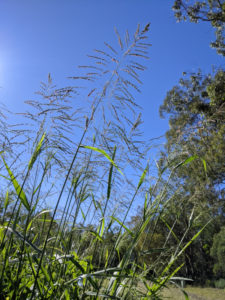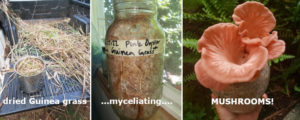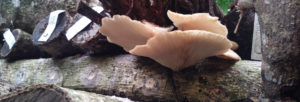We love using the log inoculation method for growing mushrooms. It is a technique to reliably grow mushrooms that mimics nature & has been used successfully for hundreds of years. Oftentimes, folks are cutting down tree limbs because the limb is threatening their house or a power line. Sometimes farmers need to open the canopy up to let more light in to grow their crops. At times, some tree species are introduced from other areas that can take over entire ecosystems & grow in an unwanted monoculture, as is the case with the Octopus Tree (aka: Umbrella Tree [H. actinophyllum / S. actinophylla]). In our tropical area, folks are regularly cutting this tree down because – without proper management – it can cover entire hillsides in short order leaving very little room for endemic species to thrive.
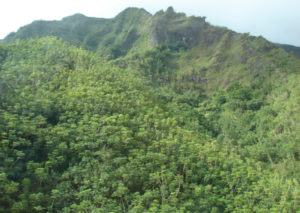
Octopus Tree taking over an entire hillside
image by Forest & Kim Starr | PlantPono.org
In each of these cases, instead of sending the wood to the landfill, we can inoculate it with mushroom mycelium to grow food for our community. Octopus Tree has been a success story in tropical mushroom cultivation on logs. The wood myceliates quickly & produces large flushes of mushrooms after only 6 months of incubation time.
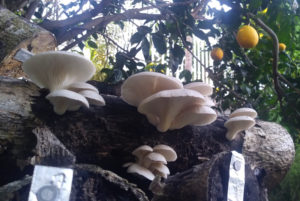
Our most recent flush of Oyster Mushrooms on Octopus Tree logs in the food forest.
Inoculated in 2021, still flushing mushrooms in 2023!
With this success, we decided to try a stump inoculation. Stump inoculation is when, after the tree has been cut down to its stump, holes are drilled in it to introduce gourmet mushroom mycelium. The living mycelium will eat the dying wood & use the nutrients in the wood to grow tasty mushrooms. Generally, since there is so much woody material in the underground root system it takes quite a while for these stumps to completely myceliate & then start producing mushrooms. But when they do, oh WOW do they ever…
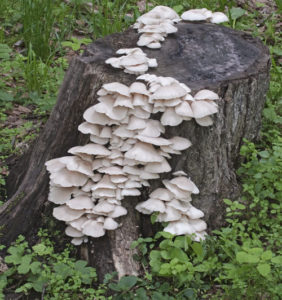
Stumps inoculated with mushroom mycelium have been known to produce mushrooms for decades!
Knowing that Octopus Tree is a very “vigorous” species & that it could possibly resist the mushroom mycelium’s vigor, we decided to drill A WHOLE BUNCH of holes in the stump & introduce A WHOLE LOT of mushroom mycelium in the holes so that the fungi would eat the wood before the tree tried to pounce back to life…
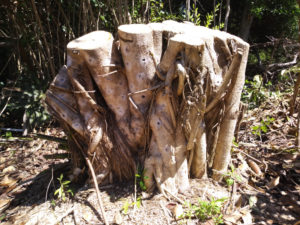
Octopus Tree with a TON of inoculation points all over & around it.
Well, like you, we are also very busy doing lots of things in life: growing mushrooms, waking up at all hours to change diapers, hiking & looking for mushrooms, washing diapers, creating new mushroom educational content, wiping baby bums, prepping & cooking mushrooms, etc.
As a result, we neglected to check up on this stump inoculation project. Plus, we knew it was a very big stump, so it would likely take quite a while to myceliate before it produced mushrooms. “Let’s just check up on it again in a couple of years”, we said to each other.
Well, that’s what we did… and here is what we encountered a couple of years later..
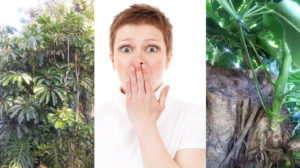
EPIC FAIL.
The tree not only survived, it is THRIVING, which is great for the tree, of course.
And we learned a lesson. We hypothesize that with a tropical tree species that is this vigorous that the best practice would most likely be to:
- Cut the tree down to the stump,
- introduce mushroom mycelium in a lot of inoculation points,
- and then REGULARLY RETURN to the stump to prune back any new growth in order to aid the mushroom mycelium in eating the stump.
While we are not 100% sure that this pruning hypothesis will work with Octopus Tree, the next time we inoculate the stump of such a vigorous tree species we will be trying a more hands-on approach!
Do you have any ideas on how to grow mushrooms on the stumps of vigorous tropical trees like this one. If so, then please contact us.
And if you would like to learn how to grow mushrooms in the tropics the fast-track way by learning what works as well as what NOT to do – because we likely already tried that – then please check out our upcoming mushroom education offerings where we will show you the ways that have worked the best for us.

